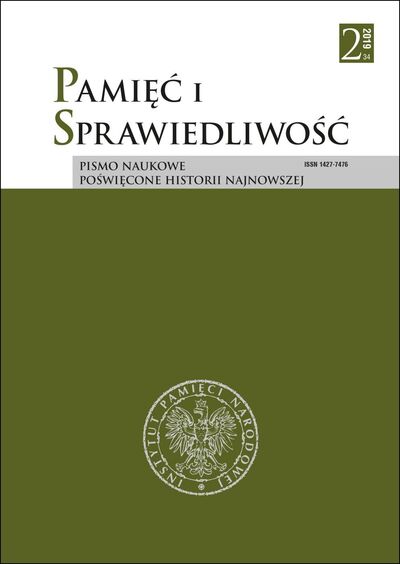The Japanese Plan to Dominate East Asia – The Greater East Asia Co-Prosperity Sphere
Pamięć i Sprawiedliwość, Том 34 № 2 (2019), pages: 234-255
Publication date: 2019-12-30
Аннотация
Библиографические ссылки
Kai Nan’yō chō tōkeinenkan, Shōwa 14-nen. [Shōwa 14-year Nan’yō Governmental Census].
HōtenHantōkampujōyaku [Treaty for Returning Liadong Peninsula] (jacar.go.jp/english/nichiro/laiodong.htm, access: 19 December 2018).
Kankokuheigō ni kansuru jōyaku [Korea Annexation Treaty] (archives.go.jp/ayumi/kobetsu/m43_1910_01.html, access: 12 March 2019).
NichimankaKyōdōSengen [Joint Japanese-Manchurian-Chinese Declaration], (dl.ndl.go.jp/info:ndljp/pid/2960671/1, access: 03 March 2019).
Nihon Koku Chūkamin Koku aida kihon kankei ni kansuru jōyaku [Treaty of Basic Relations between Japan and China](dl.ndl.go.jp/info:ndljp/pid/2960671/1, access:03 March 2019).
Nishi-Rōzenkyōtei [Nishi-Rosen Agreement] (jacar.go.jp/nichiro/incident.htm, access: 17 December 2018).
Russko-kitayskaya konventsiya in: Sbornik dogovorov Rossii s drugimi gosudarstvami [„Russian-Chinese Convention”, in: Collection of Treaties of Russia with Other States. 1856–1917], Moscow 1952.
The Report of the Lytton Commission, Columbia 1932.
Tōa Shinchitsujo, Tōa Shinchitsujo Yoron, http://dl.ndl.go.jp/info:ndljp/pid/1274449 [access: 03 March 2019).
Yamato Minzoku o Chūkaku to suru Sekai Seisaku no Kentō [An Investigation of Global Policy with the Yamato Race as Nucleus], vol. 1–3 (dl.ndl.go.jp/info:ndljp/pid/3459892, access: 20 March 2019).
Ara S., Food Supply Problem in Leyte, Philippines, During the Japanese Occupation (1942–44), “Journal of Southeast Asian Studies” 39/2008.
Beasley W.G., Japanese Imperialism 1894–1945, Oxford 1999.
Chisaka K., Sekaikakumei to shite no hakkōichiu, Shissō to shite no fashizumu, Tōkyō 2015.
Danquah F.K., Japan’s Food Farming Policies in Wartime Southeast Asia: The Philippine Example, 1942–1944, “Agricultural History” 64/1990.
Duus P., The Abacus and the Sword: The Japanese Penetration of Korea, Berkeley 1998.
Earl D.M., Emperor and Nation in Japan. Political Thinkers of the Tokugawa Period, Seattle 1964.
Fisher C.A., The Expansion of Japan: A Study in Oriental Geopolitics: Part II. The Greater
East Asia Co-Prosperity Sphere, “The Geographical Journal” 1950, vol. 115, no. 4/6.
Franchini P., Les mensonges de la guerre d’Indochine, Paris 2005.
Fuwa T., Koko ni “Rekishi kyōkasho” mondai kakushin ga aru, Tōkyō 2001.
Gotō K., Shoki Indoneshia dokuritsu kakumei to Nihon gaikōkan – Saitō Shizuo “Hōkokusho” o megutte, “Ajia Taiheiyō Kyoyō” 6/2004.
Grajdanzev A.J., Japan’s Co-Prosperity Sphere, “Pacific Affairs” 1943, vol. 16, no. 3.
Hata I., Nichibeisensō shidō 1941–1943 (nids.mod.go.jp/event/forum/pdf/2009/03.pdf, access: 20 March 2019).
Ieanaga S., Taiheiyō sensō, Tōkyō 2002.
Inoki M., Gunkoku Nihon no kōbō: Nisshin sensō kara Nicchū sensō e, Tōkyō 1995.
Iriye A., Pearl Harbor and the Coming of the Pacific War: a Brief History with Documents and Essays, Boston 1999.
Kuroiwa H., Nichiro sensō: Shōri no ato no gosan, Tōkyō 2005.
Lebra J.C., Japan’s Greater East Asia Co-Prosperity Sphere in World War II: Selected Readings and Documents, Kuala Lumpur 1975.
Mimura J., Japan’s New Order and Greater East Asia Co-Prosperity Sphere: Planning for Empire, “The Asia-Pacific Journal” 9/2011.
Mook H.J. van, The Netherlands, Indies and Japan: Their Relations 1940–1941, New York 2011.
Myers R.H., R.M. Peattie, The Japanese Colonial Empire, 1895–1945, Princeton 1984.
Nakao M., Daitōa Kyōeiken kōsō no naritachi to kokueki, “Nihon Daikgaku Daikaguin Sōgō Shakai Jōhō Kenkyūka” 9/2008.
Nihon gaikō – 1853–1972 (The Japanese diplomacy – 1853–1972), ed. S. Shinobu, Tōkyō 1975.
Nankin Senshi Henshū Iinkan, Nankin Senshi: Sōho kaitei han, Tōkyō 1993.
Office of Strategic Services Research and Analysis Branch, The Greater East Asia
Co-Prosperity Sphere, 10 August 1945: Current Intelligence Study Number 35.
Ō S., Kankoku heigō e no michi, Tōkyō 2012.
Pastreich E., Sovereignty, Wealth, Culture and Technology: Mainland China and Taiwan
Grapple with the Parameters of ’Nation State’ in the 21st Century, HAOL 7/2005.
Peattie M.R., The Japanese Colonial Empire 1895–1945, in: The Cambridge History of Japan, Vol. 6, Cambridge 1988.
Peattie M.R., Nan’yo: The Rise and Fall of the Japanese in Micronesia, 1885–1945, Hawaii 1988.
Piegzik M.A., U źródeł japońskiego nacjonalizmu i militaryzmu: doktryna kokutai w życiu politycznym Cesarstwa Japonii w latach 1867–1945, “Studia nad Autorytaryzmem i Totalitaryzmem” 2018, 40/2.
Pierson J.D., Tokutomi Sohō 1863–1957. A Journalist for Modern Japan, Princeton 1980.
Satō N., Keizai Yōroku, vol. 1–7, Tōkyō 1877.
Satō N., Kondō hisaku, Tōkyō 1888.
Sobolewski L., Indochiny Francuskie w polityce Japonii w latach 1940–1945, Warszawa 2011.
Stephan J., Hawaii under the Rising Sun. Japan’s Plans for Conquest after Pearl Harbor, Honolulu 2002.
Sun Z., Lunnánjīng datúshā yunan rénshu rending de lishǐyǎnbian, “Jianghai Academic Journal” 2001 (6).
Swan W.L., Japan’s Intentions for Its Greater East Asia. Co-Prosperity Sphere as It is an Indicated in Thailand Policy, “Journal of Southeast Asian Studies”, 1996, vol. 27, no. 1.
Tanigawa Y., Taiheiyō sensō to Tōnan Ajia minzoku dokuritsu undō, “Hōsei Kenkyū” 3/1987.
The Nation, vol. 74, New York 1902.
Tokutomi I., Ōyamato bōchōron, Tōkyō 1894.
Tokutomi S., Yoshida Shōin, Tōkyō 1893.
Valette J., Indochine 1940–1945: Français contre Japonais, Paris 1993.
Wakabayashi B.T., The Nanking Atrocity, 1937–38: Complicating the Picture, New York 2008.
Weinberg G.L., Visions of Victory: The Hopes of Eight World War II Leaders, Cambridge 2005.
Willmott H.P., Empires in the Balance: Japanese and Allied Pacific Strategies to April 1942, Annapolis 2008.
Yoshii K., Tōa Shinchitsujo Seimei no myakuraku, “Jim’mon Kagaku Kenkyū”, vol. 129/2011
 Język Polski
Język Polski
 English
English
 Deutsch
Deutsch
 Français (France)
Français (France)
 Italiano
Italiano
 Русский
Русский


 PDF (English)
PDF (English)
